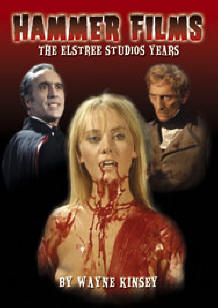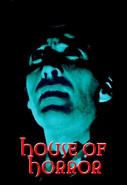|
 For a
company which has been effectively inactive for the last
twenty years it is astonishing just how much literature
has been produced. There is a cottage industry built up
around Hammer films research. I’ve heard certain fans
ask why anyone would want to write a book on Hammer when
there are so many already out there, but Wayne Kinsey
has proven yet again that there is indeed more to be
said. For a
company which has been effectively inactive for the last
twenty years it is astonishing just how much literature
has been produced. There is a cottage industry built up
around Hammer films research. I’ve heard certain fans
ask why anyone would want to write a book on Hammer when
there are so many already out there, but Wayne Kinsey
has proven yet again that there is indeed more to be
said.
Kinsey’s
name is familiar to most Hammer fans through his fanzine
series The House That Hammer Built, a popular
zine which is filled with rare stills and interview
material. The magazine itself spawned out of a desire to
write a book on Hammer, only to have it turned down by
just about every publisher in town. Independent
publisher Reynolds and Hearn took on responsibility for
the first volume which focussed on the “classic” era of
Hammer,
The Bray Studios Years. The exhaustive
tome is based largely on an oral history of the company,
delivered through countless interviews conducted by
Kinsey over the years with many key personnel and bit
players.
The Elstree Studios Years
(published this time by Tomahawk Press, whose previous
output includes
Greasepaint and Gore) picks up
where the first volume left off as Hammer abandon their
home at Bray in 1966, and ends around the time of the
first tv series. Kinsey succeeds once again in packing
the book with more information than it seems possible to
include, and lavishly illustrated with hundreds of
rarely seen images.
Elstree
is not however for the
casual reader, and even the more seasoned Hammer fan may
find bits of it hard-going. The author’s desire to
include as much information as possible, means that
trivia which would be excised by many an editor has been
retained. At times, the lists of shots and locations
seem almost incoherent, and one struggles to decide if
the repetition of style actually lessens the success of
the research itself.
Elstree
is meticulously researched, in minute detail. Perhaps
that is where the problem lies for this reviewer. When
the author includes his own criticism or commentary on
the films and events it jars with the predominantly
factual account. It’s a fine line, but one which
shouldn’t mar too many readers’ enjoyment.
The book
itself is beautifully designed and laid out. Print size
itself is very small though, and may easily cause
eye-strain, so be warned! Reading it over many many days
and nights I realise that this was simply to accommodate
all the text. The illustrations are great, and
reproduction quality is superb. It is a little
unfortunate that there is not a colour section (which is
one reason why The Hammer Story continues to be
so popular with fans), or that the illustrations
themselves have to be so small to fit in. But I would be
surprised if we don’t see larger versions of many of the
photographs in the pages of The House That Hammer
Built in the years to come.
Despite
the change of publisher, efforts have been made to
ensure that the two volumes can sit side by side on any
shelf. Both are of similar size, the spinal logos are
very similar. The paper in Elstree is however
rather thinner which ensured extra care whilst reading.
A
splendid, weighty tome. Exhaustively researched and
packed with new materials. Kinsey should be proud of his
work, and the fan community should applaud his
researches and contributions to the ongoing study of
Hammer Films.
© RJE Simpson 2007
review posted 19.10.2007 |


 -
-
